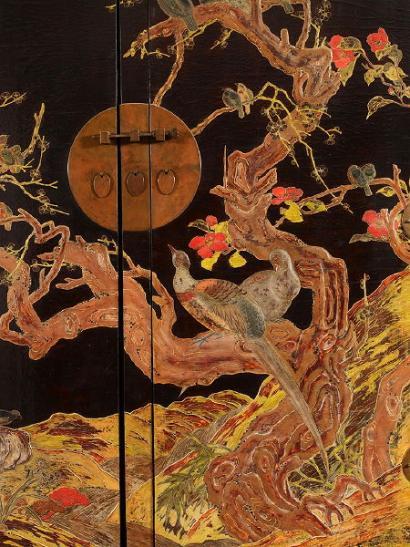
Detail of a Chinese wardrobe Kangxi period (1662-1722), lacquer, mother-of-pearl © RMN-Grand Palais (musée Guimet, Paris), Thierry Ollivier. |
|
MUSÉE NATIONAL DES ARTS ASIATIQUES – GUIMET
6, place d’Iéna 75116 Paris
INFORMATIONS
• Phone: +33 (0)1 56 52 53 44
• Website: www.guimet.fr/en
• Subway: Iéna, Trocadéro, Boissière
• Bus: n°30, 32, 63, 82
OPENING TIMES
Open every day, except Tuesdays, from 10am to 6pm.
ENTRANCE FEES
Combined ticket only (temporary exhibitions and permanent collections):
• Full fare: €9.50
•
Reduced fare: €7
CURATORSHIP
• Sophie Makariou, general curator and president of the MNAAG
• Hélène Gascuel, heritage curator
PRESS CONTACT
Hélène Lefèvre, Head of Communication
• Phone: +33 (0)1 56 52 53 32
• E-mail: helene.lefevre@guimet.fr

|
The greatness of China and the sumptuousness of its interiors
The reopening of the Hôtel d’Heidelbach could not be envisaged without a thorough presentation hitherto not imagined for this kind of work: Chinese furniture. The first-floor spaces, better suited for monumental dimensions, have now become a perfect setting for a formal furniture that in the main building – and also because it was dispersed – lacked sufficiently high ceilings. The lacquered formal furniture that aristocratic residences and imperial palaces required for their monumental dimensions and their demand for prestige, have naturally found their majestic space in harmony with the monumentality of the wardrobes and lacquered screens.
These large-sized formal pieces, sometimes produced by the imperial manufactories, were made to furnish palaces and reception rooms. Their repertory illustrates classical Chinese themes: landscapes, birds and flowers, as well as dragons that refer to the imperial iconography. The new presentation is enhanced with cloisonné enamel fittings, furnishing silks, interspersed with painting.
Splendour or secrets?
The reorganization, a museographic freshening as well as a restored unity, meant identifying the most majestic formal pieces evoking the pomp of the imperial palaces and contrasting them with scholars’ furniture, more modest in size, and characterizing scholars’ more intimate surroundings with their intentional bareness. For the latter, the new installation is in the main museum, in the Chinese Decorative Arts rooms on the 2nd floor.
The lacquers from Coromandel – the term refers to the East coast of India where the wares produced in China transited towards Europe – have found a setting worthy of their dimensions in the 1stfloor rooms of the Hôtel d’Heidelbach. The décor of these pieces, achieved by a technique arisen in the 17th century, was obtained by incising and cutting out certain parts of the lacquer ground before inlaying colour or gilding.
The mastery of space
From the mere notion of the screen, a mobile partition subtly delimiting the interior space of the public sphere, the place of honour is thus restored to this carefully crafted partition, often a prestige gift within the imperial administration, bearing on the back a commemorative inscription with the donors’ names.
Next to the furniture rooms, a space devoted to the tea ceremony in the Far East is organized around a contemporary tea room offered by the Shang Xia firm, and named Bamboo Space. Enhanced with objects from China and Japan, it is an allusion to the Japanese garden tea house made of teak and bamboo marquetry, a specialty of the Chinese province of Zhejiang ever since the 18th century.
PUBLICATION
• Chine – Le mobilier, la collection des collections. A co-edition Artlys and musée national des arts asiatiques – Guimet – 144 pages - 130 illustrations - Forthcoming November 2017.
|









